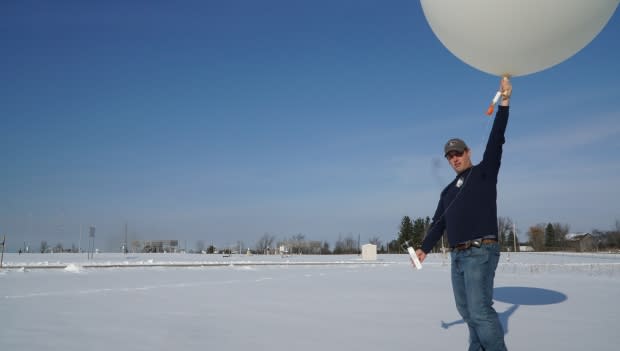It's raining junk: Weather service dumping balloons and e-waste across the landscape
Environment Canada has for years encouraged Canadians to reuse, recycle and reduce, but its weather service routinely dumps electronic waste — including batteries — across the landscape, making no efforts to recover the material.
Every day, 62 weather balloons carrying battery-powered circuit boards burst at high altitudes and drop their loads to the ground, discarded and forgotten.
That works out to 22,630 dumps of 'e-waste' each year, distributed widely, with each balloon carrying either six AA alkaline batteries or two potentially toxic lithium batteries.
The Meteorological Service of Canada, which runs the program, launches the balloons to gather vital weather data from the upper atmosphere. It shares that data with many other countries that also release their own balloons carrying these instrument packages, called radiosondes.

The electronic devices monitor high-altitude weather conditions, such as temperature, humidity and air pressure, and transmit the results by radio to 31 ground stations as far afield as Eureka, Nunavut, and Sable Island, N.S. The newest versions weigh about 100 grams each.
But unlike the United States, which attempts to recover and re-use some of these devices, Canada simply leaves the balloons and their radiosondes wherever they happen to fall — which is often in remote and pristine wilderness areas and in waterways.
"They should at least try to recover as much as they can," said Vancouver-based Amit Kumar, who is writing his PhD thesis at the University of British Columbia on the fate of electronic waste in Canada.
"The U.S. is also a big country. If it can be done in the U.S., it can be done in Canada. As an organization, they [Environment Canada] should have a responsibility for recycling."
Too costly?
But a spokesperson for Environment Canada said recovering the delicate circuit boards would sharply drive up the cost of the $17-million-per-year Upper Air Observation program.
"Even if this simple concept was feasible, it would not work in a large area without local populations or road access, as it would be prohibitively expensive," Gabrielle Lamontagne said in an email, saying the abandoned e-waste is the price of obtaining accurate forecasts.
"The environmental and safety benefits of high-quality forecasts are significant."
The twice-a-day launches from 31 stations use helium- or hydrogen-filled balloons made of biodegradable, natural latex, which the department says will disappear harmlessly over time after the burst remains fall back to Earth.
Environment Canada is gradually replacing its inventory of heavier, AA-battery-powered Finnish radiosondes with lighter, lithium-battery-powered radiosondes made in Germany, at a current cost of between $100 and $130 each.
... if it can be done in the U.S., it can be done in Canada - E-waste specialist Amit Kumar on Environment Canada's policy of discarding electronic weather packages
An information sticker on each device asks the finder to contact Environment Canada, but the department receives only a few calls each year, said spokesperson Samantha Bayard.
She added that the department has only rarely paid compensation for damage caused by a radiosonde falling back to Earth, but did not provide details.
Toxic mercury has been eliminated from the batteries, and the AA alkalines are considered relatively benign. Lithium batteries, however, often are toxic and can pose a fire hazard.
"The batteries do pose some environmental risk," said Bayard. "However, the data obtained [from the radiosondes] has great importance both globally and to Canada."
Kumar said the e-waste problem posed by radiosondes extends beyond the direct hazards from their batteries.
"It takes a lot of resources to manufacture these things," he said, citing the work of mining the minerals and the energy and water used in their construction. "All these things add up."
Environment Canada says it is examining alternatives, such as using ground-based instruments to monitor upper-air conditions, but insists nothing available now can replace the accuracy and precision of weather balloon data.

Cost-benefit analysis
France has experimented with a parachute-based system to recover its radiosondes. Switzerland recovers and re-uses more than 60 per cent of the devices that it launches. It has been estimated that the United States reuses about 18 per cent of its radiosondes.
Kumar said Environment Canada should at least perform a cost-benefit analysis to support its decision not to recover, noting that the electronics in a radiosonde can be recycled easily.
"The good thing about a radiosonde is most of the things that can be recycled from it. There are already recycling facilities doing it," he said.
Christine Best, director of the Radar and Upper Air section at the Meteorological Service of Canada, said recovering radiosondes "in the middle of nowhere" using helicopters and snowmobiles would be prohibitively expensive.
"It's a concern, and we've been working with industry, everyone's been working with industry globally, to minimize the battery, minimize the plastic."
Using data from 2014, Kumar estimates that only about 20 per cent of the 725,000 tonnes of e-waste generated in Canada that year was collected for proper disposal or recycling. Much of the remainder ended up in landfills, where there is a risk of toxins seeping into groundwater and contaminating soil.
"E-waste is a growing concern, not just in Canada but across the world," says a paper Kumar co-authored.
"The e-waste collection in Canada has increased in recent years; however, the overall e-waste collection rate is very low compared to the e-waste generation rate."

